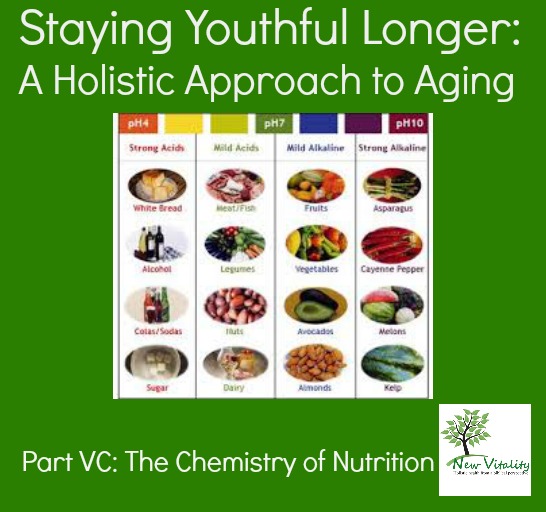Vim & Vitality Blog
Staying Youthful Longer: A Holistic Approach to Aging
Part VC: The Chemistry of Nutrition
 In this part of Staying Youthful Longer, we have been discussing The Chemistry of Nutrition as a factor that regulates the speed at which we age. There are four dietary recommendations that I make to all of my clients, and so far we have covered the first two:
In this part of Staying Youthful Longer, we have been discussing The Chemistry of Nutrition as a factor that regulates the speed at which we age. There are four dietary recommendations that I make to all of my clients, and so far we have covered the first two:
1)Drink ½ your body weight in ounces of water (and clear liquids such as herbal tea) each day
2)Drink room temperature water continually, separating from meals by 1 hour, and drink hot water before meals for optimum digestion
The third piece of nutritional advice I give to every client is:
Follow the 80/20 rule for pH of foods in your diet
This rule focuses on the dietary balance between foods that produce alkaline compounds in the body vs. acidic ones: Shoot for balancing your diet with 80% alkaline and 20% acid-forming foods. Remember the question I asked in Part VA of this blog series? True or False: Meat has an alkaline pH. With all of the hype about cancer and how an acidic body chemistry produces a friendly environment for cancer to thrive, most Americans are aware of meat being a major contributor to an acid pH in the body. However, you may have been surprised to learn that meat actually has an alkaline pH OUTSIDE of the body! It is when we METABOLIZE meats that acids are created in our bodies, and even more so if our digestion is not functioning properly. Of course, some meats are more acid-forming than others: Beef, pork and shellfish produce the highest acid content our bodies, while poultry, fish, venison, and lamb are less acid-forming. The same is true of other foods too. For instance, white refined sugars and flours produce more acid in the body than natural sweeteners, such as stevia, xylitol, honey, and even raw sugar. Incidentally, artificial sweeteners are very acid-forming in our systems as well, so think twice before you reach for NutriSweet or Splenda. For the most part, by simply avoiding processed foods and consuming whole foods in their natural form instead, especially fresh fruits and vegetables, we create a more an alkaline environment in our bodies. Learn more about Preventing & Fighting Cancer Holistically by downloading my eBook.
Now for a brief lesson on The Chemistry of Nutrition. The first of two factors that determines the pH of foods in the body is: Mineral Content, i.e., Electrolytes. The mineral content in the foods we eat produces acid or alkaline compounds in our bodies. Some minerals have a high potential for hydrogen (pH), and are thus considered to be alkaline. This means that hydrogen molecules are easily able to attach to these minerals. Hydrogen produces acid in the body, likewise oxygen yields an alkaline pH in the body. If an alkaline compound takes on additional hydrogen molecules, then the pH of that compound will drop and become more acidic (which is a low pH, or low potential for hydrogen). On the flip side, certain minerals already have a low hydrogen content, or high acidity, thus reducing the potential for outside hydrogen molecules to attachâthese molecules have a higher potential for another element to attach instead, such as oxygen. For some of my readers, this may be enlightening information, but for others, the chart below may contain all of the facts that you care to know about pH and how to optimize your nutrition:
|
Alkaline Mineralsâ80% |
Acidic Mineralsâ20% |
||
|
Sodium |
Sea Vegetables |
Sulfur |
Onions, Garlic |
|
Potassium |
Bananas, Potatoes |
Phosphorus |
Cheese, Some Seeds & Nuts |
|
Magnesium |
Corn |
Chlorine |
Cabbage, Cruciferous Vegetables, Nightshades |
|
Calcium |
Almonds |
||
Click Herefor a FREE list of Acid vs. Alkaline Foods, including ranges of pH.
In the next installment of this blog series, I will talk about the second factor that determines the pH of a food, and then I will give you the fourth dietary recommendation that I make to all of my clients. If you have found this blog to be informative and helpful, share it with the people you know.
LâchaimâTo Life!
When you subscribe to the blog, we will send you an e-mail when there are new updates on the site so you wouldn't miss them.

Comments